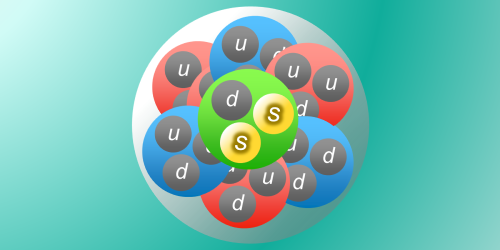Doubly Strange Nucleus Observed
Baryons are three-quark particles, such as protons, neutrons, and the lesser-known hyperons. The latter’s claim to fame is that they contain at least one strange quark. Researchers study hyperons to understand how baryons interact. One experiment, known as the J-PARC E07 experiment, has now uncovered a very rare interaction in which a hyperon with two strange quarks binds to a normal nucleus [1]. By measuring precisely how this “hypernucleus” decayed, the team behind the experiment was able to determine the particles’ binding energy.
The collaboration directed a beam of K mesons from J-PARC (the Japan Proton Accelerator Research Complex) into a diamond target. Collisions in the target produced hyperons—specifically hyperons that are made up of two strange quarks and one down quark. These hyperons then traversed a stack of photographic sheets that recorded the particle tracks. Using an automated track-identification system, the team extracted an event where a hyperon bonded with a nitrogen nucleus, briefly forming a doubly strange hypernucleus.
Only a handful of doubly strange hypernuclei have been seen before—in fact the events are so rare that they are often given their own names. The J-PARC E07 team has christened their event IBUKI, which is the name of a mountain on the Japanese main island. By identifying the decay products in this event, the team determined that hyperons bind to nitrogen nuclei with an energy of 1.27 MeV, which agrees with theoretical predictions. As more data are processed, the researchers expect to find roughly ten more -hyperon events, which could provide insights for nuclear physics as well as for theories of neutron star models.
–Michael Schirber
Michael Schirber is a Corresponding Editor for Physics Magazine based in Lyon, France.
References
- S. Hayakawa et al., “Observation of Coulomb-assisted nuclear bound state of – system,” Phys. Rev. Lett. 126, 062501 (2021).




